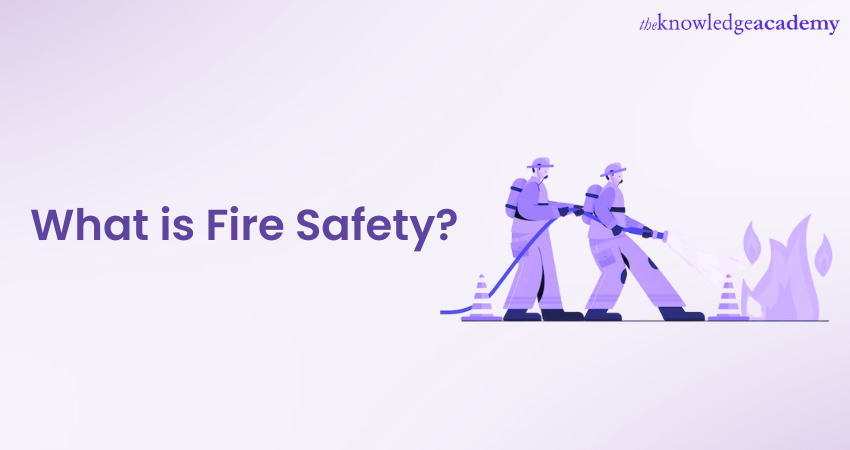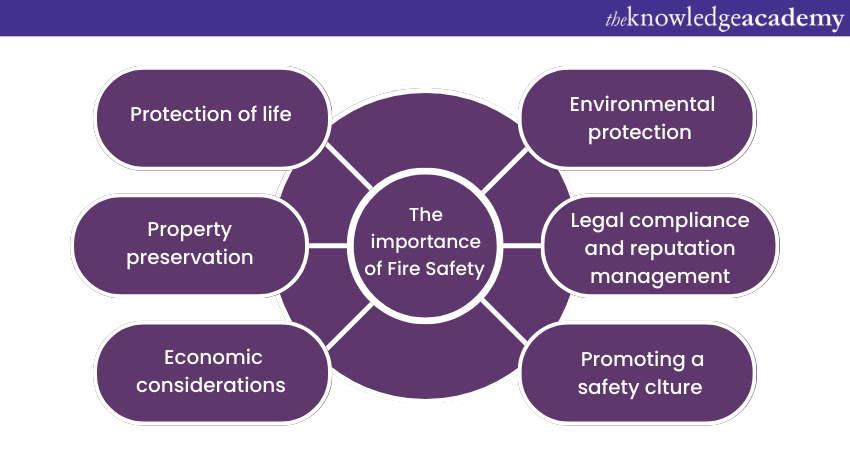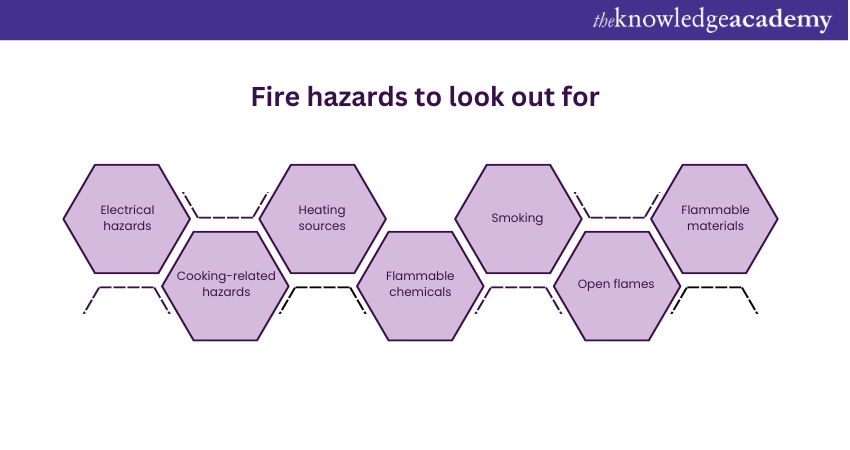We may not have the course you’re looking for. If you enquire or give us a call on +46 850282424 and speak to our training experts, we may still be able to help with your training requirements.
Training Outcomes Within Your Budget!
We ensure quality, budget-alignment, and timely delivery by our expert instructors.

Fire is a friend and a foe, a blessing and a curse. It warms our homes, cooks our food, and lights our way. But it can also burn, destroy, and kill. That’s why it’s important to understand What is Fire Safety and how to apply it in different settings. Fire Safety is the art of mastering fire and preventing its wrath.
As per Statista, fire accounted for 1% of fatal workplace injuries in the UK in 2023. Every year, fire claims thousands of lives and properties around the world. Fire Safety is not a luxury but a necessity. It can save you and your loved ones from a fiery fate. Thus, understanding this topic has become more crucial than ever. In this blog, we will show you how to be a Fire Safety hero by explaining What is Fire Safety and why it matters.
Table of Contents
1) Understanding What is Fire Safety
2) The importance of Fire Safety
3) Fire hazards to look out for
4) Fire Safety measures
5) What to do during a Fire outbreak?
6) Fire Safety standards and regulations
7) Conclusion
Understanding What is Fire Safety
It's critical to understand What is Fire Safety in order to safeguard property and people from the terrible effects of fire. A broad range of rules and regulations are included in fire safety in order to both prevent fires from starting and mitigating their effects if they do.
It includes an extensive plan that includes measures for both fire safety and prevention. Fire protection involves establishing methods to detect, minimise, and control fires, like installing sprinkler systems and fire alarms. On the other hand, fire prevention focuses on identifying and eliminating fire hazards, such as defective wiring or ignitable substances.
Moreover, developing and implementing emergency evacuation plans into practice, as well as understanding fire safety rules, regulations, and procedures, are all part of understanding What is Fire Safety. Individuals and organisations can make safer environments, lower the chance of fire-related incidents, and decrease the possibility of both property and human harm by being aware of the basic principles of fire safety.
The importance of Fire Safety
Fire Safety is vital to maintaining secure environments in our daily lives, whether at home, in the workplace, or in public places. Its significance extends far beyond mere compliance with regulations; it also impacts everyone directly and indirectly. So, let’s explore why Fire Safety is so crucial:

Protection of life
Certainly, the most important part of Fire Safety is the preservation of human life. In many cases, smoke inhalation rather than direct flame exposure is the cause of severe injuries or even deaths caused by fires. Effective fire safety measures are therefore important in avoiding such disasters. Examples of these precautions include emergency evacuation plans, fire detection and control systems.
Property preservation
Fires can damage significant property by destroying buildings, equipment, and personal belongings. Apart from the initial destruction, fires often lead to costly repair and rebuilding efforts. Therefore, ensuring Fire Safety at all places helps protect properties and valuables from fire damage.
Economic considerations
Fires may result in an enormous adverse effect on the economy. After a fire, a business may suffer from destroyed items, operational delays, or even shut down completely. Individuals may also face temporary displacement or permanent loss of their homes. The cost of fire response, recovery, and insurance can be substantial. In such cases, taking proactive Fire Safety measures can help avoid these economic hardships.
Environmental protection
The environment can be severely damaged by fires, particularly those that occur on a huge scale. They have a chance to cause climate change, ruin wildlife habitats, and release dangerous pollutants into the atmosphere. It is necessary for environmental preservation to put fire safety measures into effect, especially in high-risk regions like industrial zones and forests.
Legal compliance and reputation management
Businesses are legally obligated to adhere to Fire Safety regulations. Failure to comply can lead to fines, prosecution, or closure. Additionally, a poor Fire Safety record can damage a business's reputation, thereby leading to a loss of customer trust and potential revenue. Therefore, maintaining high safety standards is essential from a legal and reputational standpoint.
Promoting a safety culture
Learning What is Fire Safety highly fosters a culture of safety. It encourages individuals to be aware of their surroundings, understand the risks, and take proactive steps to prevent accidents. This mindset is beneficial not only for Fire Safety but also for promoting overall health and safety in various environments.
Take the first step towards safeguarding your environment with our Fire Extinguisher Training – join now!
Fire hazards to look out for
It's important to understand the possible hazards of fire. This might help both organisations and individuals in taking preventive measures while creating an effective fire safety system. Examples of possible fire threats in residences, business premises, or public environments include the following:

1) Electrical hazards: Electrical risks include damaged electrical cords, overloaded circuits, and broken electrical equipment.
2) Cooking-related hazards: Cooking-related risks include oil accumulation, cooking without supervision, and improper use of kitchen appliances.
3) Heating sources: Inappropriate use of room heaters, wood-burning stoves, and portable heaters.
4) Flammable chemicals: Paint thinners, petroleum products and solvents
5) Smoking: Discarding smoking materials and cigarette butts carelessly
6) Open flames: Open flames, incense, and candles left unattended
7) Flammable materials: Paper, cardboard, textiles, and flammable gasses
Fire Safety measures
The implementation of suitable fire safety measures is important to ensuring the safety of individuals and their belongings, reducing the probability of fires, and preventing their loss. These steps fall into two categories: fire prevention and fire protection, and they are essential to understanding what fire safety is. Here's a detailed explanation of these categories:
Fire prevention
Fire prevention focuses on eliminating the factors that can cause a fire or significantly reduce its likelihood. It is a proactive approach that requires careful planning and regular inspections. Below are some essential elements of fire prevention:
a) Safe handling and storage of flammable materials
b) Regular inspection and maintenance of electrical systems
c) Proper waste management
d) Control of open flames
Fire protection
While fire prevention aims to stop fires from starting, fire protection measures are put in place to limit the spread and impact of a fire if one does occur. These measures involve the design of the building and the use of equipment to detect and control fires. Below are some critical elements of fire protection:
a) Installation of fire detection systems
b) Use of fire suppression systems
c) Design of fire-safe spaces
d) Emergency evacuation plans
e) Regular fire drills
What to do during a fire outbreak?
It's essential to react quickly and follow protocol during a fire outbreak. Here are some guidelines for fire safety that must be followed:
1) You can accomplish this by shouting "Fire!" to alert everyone nearby or switching on the nearest fire alarm. People can respond effectively to the threat more quickly if they are all aware of it immediately.
2) Follow the specified paths for evacuation. Doors should be checked for heat before being opened; if they feel hot, there might be a fire on the other side.
3) Stay low to the ground, where the air is less toxic, and crawl on your hands and knees to prevent breathing in smoke and toxic gases.
4) Shut doors behind you to prevent the spread of smoke and fire as well as to safeguard routes of escape. This will give people more time to leave safely.
5) While evacuating, always use the staircases, especially in buildings with multiple floors, as elevators may break down during a fire outbreak or take you to a floor that is harmed.
6) Try to stay calm and focused. Advise others to maintain their calmness.
7) If you find yourself in a public area, pay attention to the instructions and emergency procedures given by the staff or emergency services.
8) If it's safe to do so, offer help to whoever you come across, specifically who is unable to escape on their own. As soon as you are able, let rescue workers or firefighters know where you are.
9) Until the authorities decide that it is safe to do so, avoid going back inside the building once you have safely escaped. It is important to wait for expert advice because fire conditions might change quickly.
10) As soon as you're in a safe place, give emergency services a call by dialling their number (999 in the UK and 112, which is an internationally recognised emergency number). Give them exact details about the fire, where you are, and any people who might still be inside.
Fire Safety standards and regulations
The UK Fire Safety (England) Regulations 2022, governed by the Fire Safety Act 2022, ensure the safety of occupants in residential and non-residential buildings. They include measures like the installation of alarm systems, making escape routes, fire detection, and assessments of the risk of fire. Owners of buildings are in charge of compliance; however, non-compliance might result in penalties.
In order to avoid fires and safeguard people and property, regulations are implemented for residential, commercial, and industrial structures. These standards are observed by local fire authorities through regular inspections and enforcement, placing public safety first throughout the United Kingdom.
Conclusion
Fire Safety is an essential component of any safety plan, be it at home, school, or the workplace. Understanding the nature of fire, implementing appropriate safety measures, complying with regulations, and undergoing proper training are crucial to mitigating fire risks and maintaining safety. Hope we answered all your queries about “What is Fire Safety”!
Become a certified fire warden today and ensure workplace safety with our Fire Warden Training!
Frequently Asked Questions

The three pillars of fire safety are prevention, preparation, and protection. These include taking precautions to safeguard against fire, being ready for emergencies, and minimising injury and death from fire.

A basic fire safety strategy defines procedures for preventing fires, ensuring secure evacuation, and maintaining the maintenance of firefighting equipment. It gives priority to safety measures like personnel training, regular checks, and rescue procedures.

The Knowledge Academy takes global learning to new heights, offering over 30,000 online courses across 490+ locations in 220 countries. This expansive reach ensures accessibility and convenience for learners worldwide.
Alongside our diverse Online Course Catalogue, encompassing 17 major categories, we go the extra mile by providing a plethora of free educational Online Resources like News updates, Blogs, videos, webinars, and interview questions. Tailoring learning experiences further, professionals can maximise value with customisable Course Bundles of TKA.

The Knowledge Academy's Knowledge Pass, a flexible prepaid voucher system, offers the freedom to enrol in courses over a 12-month period. Start your limitless learning adventure with us and embrace education that knows no bounds.

The Knowledge Academy offers various Fire Safety Training, including Fire Safety Training, Fire Warden Training, Fire Extinguisher Training and Fire Risk Assessment Training. These courses cater to different skill levels, providing comprehensive insights into the Fire Safety System.
Our Health & Safety Blogs cover a range of topics related to Fire Safety, offering valuable resources, best practices, and industry insights. Whether you are a beginner or looking to advance your Health and Safety skills, The Knowledge Academy's diverse courses and informative blogs have you covered.
Upcoming Health & Safety Resources Batches & Dates
Date
 Fire Safety Training
Fire Safety Training
Fri 21st Feb 2025
Fri 27th Jun 2025
Fri 26th Sep 2025
Fri 21st Nov 2025







 Top Rated Course
Top Rated Course



 If you wish to make any changes to your course, please
If you wish to make any changes to your course, please


